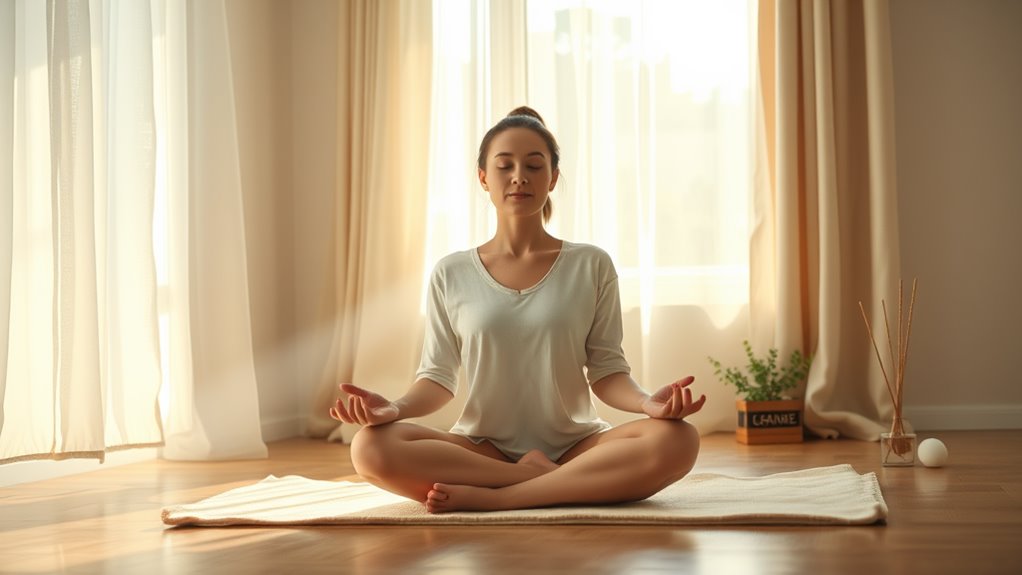Are You Doing This Wrong. The Right Way to Meditate for Beginners
You might be overlooking some key aspects of meditation. Start by finding a quiet, clutter-free space where you can sit comfortably. Use a timer to structure your sessions, beginning with just 3 to 5 minutes to avoid feeling overwhelmed. Embrace a non-judgmental attitude toward your thoughts, using your breath as an anchor. Experiment with different techniques to find what resonates. Discovering the right approach can enhance your practice, so keep exploring to reveal its full potential.
Key Takeaways
- Choose a quiet, comfortable space free from distractions to enhance your meditation experience.
- Start with short sessions of 3 to 5 minutes to build confidence and avoid overwhelm.
- Use a timer to establish a structured routine and eliminate concerns about timekeeping.
- Explore various techniques like mindfulness and concentration to find what resonates with you.
- Practice self-kindness and observe negative thoughts without judgment to foster a nurturing meditation practice.
Finding Your Space for Meditation
Finding the right space for meditation is essential to creating a calming practice. You don’t need a dedicated room; even a quiet corner will do. Aim for a location that minimizes distractions, helping you focus on your breathing and meditation. Just five minutes of focused breathing can transform your day and enhance your overall experience.
A comfortable seat, whether it’s a chair or cushion, enhances your experience, while good ventilation and balanced temperature keep your mind alert. A relatively quiet space is beneficial for beginners, allowing you to settle into mindfulness more easily. Keep your space clutter-free and decorated minimally to avoid visual distractions.
Incorporate meaningful objects that resonate with you, like candles or calming images. By consistently using the same area, you’ll create a sacred environment that fosters mindfulness and stability in your practice.
Make this space uniquely yours, and let it inspire your journey toward mastery.
Setting a Timer for Your Practice
Setting a timer for your meditation practice is essential for effective time management. It helps you stay focused and consistent, allowing you to customize session lengths that suit your needs. By providing a structured framework, timers foster regularity and help you develop a habit of meditation. Additionally, incorporating deep breathing techniques during your sessions can enhance relaxation and further reduce stress levels.
Importance of Time Management
While establishing a meditation practice, managing your time effectively is crucial for maintaining consistency and focus. Setting a timer for your sessions helps you create structured practice times, which fosters a routine that enhances your commitment.
Without a timer, you might find yourself distracted by thoughts of the clock, interrupting your mindfulness. By using timers, you can enjoy uninterrupted focus, allowing for deeper relaxation. Many timers offer customizable features, enabling you to tailor your session lengths and intervals to align with your goals. This not only keeps your practice engaging but also supports your journey toward mastery. Consistent meditation leads to long-term benefits that enhance your overall mental well-being, including improved breathing techniques that can further aid in stress relief.
Incorporating timed meditation into your daily life guarantees you allocate dedicated time for self-care, promoting long-term mental well-being and clarity.
Enhancing Focus and Consistency
To enhance your focus and consistency during meditation, using a timer can be a game changer. Timers help eliminate distractions, allowing you to dive deeper into your practice. They establish a structured routine and encourage regular scheduling, making meditation a daily habit. Plus, with interval alerts, you can shift smoothly between techniques, enhancing mindfulness and self-awareness. This is particularly beneficial for those looking to increase session duration gradually as they become more comfortable with their practice. Additionally, focusing on your breath during meditation can significantly improve your overall breath control and deeper relaxation experience.
| Benefits of Using a Timer | Explanation |
|---|---|
| Reduced Distraction | Focus on meditation without time worries. |
| Enhanced Relaxation | Less anxiety leads to a calmer mind. |
| Consistency Through Scheduling | Set regular meditation times for success. |
Customizing Session Lengths
Customizing the length of your meditation sessions can make a significant difference in your practice, especially as a beginner.
Start small and gradually build your sessions to create a sustainable routine. Here are some tips to help you set the right timer for your practice:
- Begin with 3 to 5-minute sessions to avoid overwhelm.
- Focus on frequency; daily practice is more effective than longer, infrequent sessions.
- Use guided meditations initially to maintain your focus and structure.
- Adjust your session length incrementally, adding 1 to 2 minutes as you grow more comfortable.
Incorporating simple breathing techniques can also enhance your mental clarity during these sessions.
The Importance of Natural Breathing
Natural breathing is essential for enhancing your meditation experience.
By practicing deep breathing techniques, you can boost your oxygen intake while promoting relaxation and clarity of mind.
Focusing on your breath helps you stay present, reducing distractions and increasing your overall mindfulness.
Benefits of Deep Breathing
Deep breathing offers numerous benefits that can greatly enhance your overall well-being.
By incorporating deep breathing into your routine, you can experience significant improvements in various areas of your life:
-
Stress Reduction: Activate your parasympathetic nervous system to alleviate anxiety and stress.
-
Cognitive Enhancement: Boost your focus and mental clarity, leading to improved performance and memory.
-
Emotional Well-being: Manage symptoms of depression and stabilize your mood effectively.
-
Physical Health: Enhance cardiovascular health and improve sleep quality, benefiting your overall physical condition.
Techniques for Breath Awareness
Breath awareness is a fundamental aspect of meditation that emphasizes the importance of allowing your breath to flow naturally. Focus on the sensation of air entering and leaving your nostrils, noting how your belly expands and contracts.
| Step | Action | Sensation |
|---|---|---|
| Setup | Choose a quiet space | Calmness envelops you |
| Posture | Sit upright | Spine aligned, energy flows |
| Focus | Feel the cool air | Invigorating inhale |
| Acknowledge | Notice thoughts | Let them drift away |
With consistent practice, you’ll refine your ability to anchor your awareness on your breath, enhancing mindfulness and clarity in your meditation journey. Embrace this natural rhythm, and let it guide you toward mastery.
Maintaining a Non-Judgmental Attitude
While you meditate, maintaining a non-judgmental attitude is essential for fostering a deeper awareness of your thoughts and feelings. This practice allows you to observe your inner experience without the interference of labels or biases.
Here are four key strategies to help you cultivate this attitude:
-
Mindful Observation: Acknowledge thoughts and sensations as they arise, without attachment.
-
Self-Compassion: Treat yourself with kindness, recognizing that judgments are natural but don’t define you.
-
Neutral Perspective: Aim to observe your experiences from a detached viewpoint, free from aversion or desire.
-
Regular Practice: Commit to consistent meditation, even for a few minutes daily, to strengthen your non-judgmental awareness over time.
Embrace these techniques, and you’ll enhance your meditation journey considerably.
Exploring Different Meditation Techniques
When you start exploring meditation techniques, you’ll find a variety to choose from, like mindfulness and concentration practices.
You might also consider guided sessions or loving-kindness meditation, each offering unique benefits.
Experimenting with these methods can help you discover what resonates best with you.
Mindfulness vs. Concentration
Understanding the difference between mindfulness and concentration meditation can enhance your practice considerably. Each technique offers unique benefits, and mastering both can elevate your meditation experience.
-
Mindfulness: Focus on being aware of your thoughts and emotions without judgment, fostering acceptance.
-
Concentration: Zero in on a single object, like your breath or a mantra, to cultivate a steady focus.
-
Approach: Mindfulness embraces all experiences; concentration hones in on one, providing clarity.
-
Benefits: Combining both techniques can lead to deeper insights, better emotional regulation, and a more balanced practice.
Guided vs. Loving-kindness
Two popular meditation techniques, guided meditation and loving-kindness meditation, offer distinct paths for enhancing your practice.
Guided meditation provides structure, making it ideal for beginners. You’ll follow a teacher or recording, which helps maintain focus and integrates meditation into your routine. Techniques like body scans and breath awareness help reduce stress and improve concentration.
On the other hand, loving-kindness meditation focuses on cultivating compassion towards yourself and others. By silently repeating phrases of goodwill, you foster emotional connections and inner harmony.
While guided meditation is generally more accessible, loving-kindness encourages personal emotional journeys. Both techniques can enhance your practice, so consider experimenting with each to discover what resonates best with you.
Starting With Short Sessions
Starting with short meditation sessions can be a game-changer for beginners. By keeping your sessions brief, you can establish a consistent practice that feels manageable.
Here are some benefits of starting small:
-
Build Confidence: Begin with just 2 minutes to ease into meditation.
-
Enhance Mood: Even 5-minute sessions can lift your spirits and reduce anxiety.
-
Boost Focus: Short daily practices improve attention and emotional regulation over time.
-
Fit Your Schedule: Short sessions adapt easily to busy lifestyles, increasing adherence.
Recognizing and Redirecting Wandering Thoughts
After establishing a routine with short meditation sessions, you might notice your mind wandering more often than you’d like. This is completely normal; mind-wandering is a natural aspect of meditation. Recognizing when your thoughts drift is essential for effective practice.
Instead of engaging with those thoughts, observe them neutrally, allowing them to pass like bubbles. This practice enhances your meta-awareness and helps you redirect your focus back to your breath or physical sensations. Use your breath as an anchor, gently guiding your attention whenever distractions arise.
Embracing Kindness Towards Yourself
Embracing kindness towards yourself is an essential aspect of meditation that can transform your practice and overall well-being.
By incorporating self-compassion into your meditation, you create a nurturing space that enhances your connection with yourself.
Here are four key points to reflect on:
-
Recognize Negative Self-Talk****: Observe your thoughts without judgment and realize they don’t define you.
-
Practice Loving-Kindness****: Wish yourself happiness and health through phrases like “May I be happy.”
-
Use Body Scans: Identify sensations in your body to foster awareness and acceptance.
-
Engage in Regular Practice****: Consistency builds self-discipline and deepens self-love.
Popular Techniques for Beginners
Cultivating kindness toward yourself sets a strong foundation for meditation, making it easier to explore various techniques that can enhance your practice. Here are some popular methods to evaluate:
| Technique | Description |
|---|---|
| Focus on Breathing | Center your attention on your breath to calm the mind. |
| Use of Mantras | Repeat a word or phrase to maintain concentration. |
| Visualization | Imagine a serene scene to deepen relaxation. |
| Body Scan Meditation | Systematically release tension by scanning your body. |
Experiment with these techniques to find what resonates with you. Each method can sharpen your focus, deepen your awareness, and enrich your meditation experience as you progress on your journey toward mastery.
The Benefits of Regular Meditation Practice
Regular meditation practice offers a wealth of benefits that can transform your emotional, cognitive, physical, and social well-being. By committing to this practice, you’ll experience:
-
Improved Mood: Feel a lift in your mood as meditation reduces anxiety and depression.
-
Enhanced Focus: Sharpen your concentration and attention span, helping you stay present and productive.
-
Better Relationships: Cultivate empathy and emotional regulation, leading to deeper connections with others.
-
Physical Health Boost: Enjoy better sleep, reduced blood pressure, and a stronger immune system.
Embracing meditation not only elevates your inner state but also enhances your interactions with the world around you.
With consistent practice, these benefits become a natural part of your daily life, empowering you to master your mind and emotions.
Incorporating Meditation Into Your Daily Life
To reap the full benefits of meditation, it’s important to integrate it into your daily life. Start small with brief sessions of 1-5 minutes to make it manageable. Set a specific routine, designating times that work best for you, and utilize reminders to stay on track.
Create a comfortable meditation space that promotes focus and relaxation. Engage with a community—whether local or online—for support and motivation. As you practice, focus on your breath and observe your thoughts without judgment.
Incorporate mindfulness into daily activities like eating or walking. Remember to celebrate your progress and gradually increase your meditation duration as you become more comfortable. Consistency is key in cultivating a rewarding meditation practice.
Frequently Asked Questions
How Do I Know if I’m Meditating Correctly?
When it comes to knowing if you’re meditating correctly, remember, practice makes perfect. Focus on your breath, notice thoughts without judgment, and enjoy the process. Consistency and patience will lead you to mastery.
What Should I Do if I Feel Restless During Meditation?
If you feel restless during meditation, acknowledge those feelings without judgment. Try gentle breathing techniques or short movements, and focus on consistency rather than duration. Remember, it’s okay to pause and resume later if needed.
Can I Meditate While Lying Down?
Meditating while lying down can feel like floating on a cloud—comforting and soothing. Just guarantee you stay alert, use mindful breathing, and create a peaceful environment to harness its full potential for relaxation and focus.
Is There a Best Time of Day to Meditate?
There isn’t a one-size-fits-all answer for the best time to meditate. You should choose a time that aligns with your schedule and energy levels, ensuring consistency for maximum benefits and effective practice.
How Long Should I Meditate to See Benefits?
Like a gentle stream carving a path through stone, even five to ten minutes of daily meditation can yield profound benefits. Consistency is key—gradually increase your time as you become more comfortable and attuned.
References
- https://www.mindful.org/how-to-meditate/
- https://www.gaiam.com/blogs/discover/meditation-101-techniques-benefits-and-a-beginner-s-how-to
- https://www.headspace.com/meditation/meditation-for-beginners
- https://www.nowaboutmeditation.com/p/tips-for-meditation-start-small-and-slow
- https://www.tm.org/en-us/blog/meditation-techniques
- https://www.alwayswellwithin.com/blog/2018/02/17/simple-meditation-space
- https://www.headspace.com/meditation/how-to-meditate
- https://www.thegoodtrade.com/features/meditation-room-ideas/
- https://thefoundationblog.com/blog/meditation101
- https://leftbrainbuddha.com/create-a-meditation-space-in-your-home/





